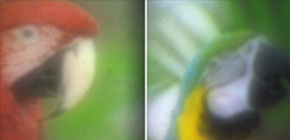
No more focus adjustment -- significantly extending depth-of-field of projector succeeded
Will lead to more accessible projection mapping for a wider audience to use and enjoy
A research group led by Prof. Kosuke Sato and Assoc. Prof. Daisuke Iwai in Graduate School of Engineering Science, Osaka university, developed a novel extended depth-of-field projector by placing a fast focus tunable lens (FTL) in front of a projector´s objective lens, and consequently achieved a focus-adjustment-free projector. By leveraging liquid lens technology, the focal length of a projector can be periodically modulated at a frequency that is higher than the critical flicker fusion (CFF) frequency, i.e., human observers cannot perceive the modulation. Fast periodic focal length modulation results in forward and backward sweeping of focusing distance. Fast focal sweep projection makes the projected results focused at any point within the sweep range. Through experiments using a prototype system, they have confirmed that the image quality of the proposed method is superior to that of normal projection with fixed focal length. In addition, they demonstrate that a structured light pattern projection technique using the proposed method can measure the shape of an object with large depth variances more accurately than normal projection techniques. This technology has a potential to be appreciated in many application fields, such as (1) digital signage and projection-mapping shows where projected image qualities on non-planar surfaces can be significantly improved, (2) presentations where people are released from cumbersome focus adjustment tasks, and (3) robot vision where significantly more accurate shape measurement is realized.
This research was presented at IEEE Virtual Reality Conference (VR) 2015 and got the best paper award. IEEE VR is one of the most influential international conferences on virtual reality.
Daisuke Iwai, Shoichiro Mihara, and Kosuke Sato, "Extended Depth-of-Field Projector by Fast Focal Sweep Projection," IEEE Transactions on Visualization and Computer Graphics (Proceedings of IEEE Virtual Reality 2015), Vol. 21, No. 4, pp. 462-470, 2015.
Abstract
A simple and cost-efficient method for extending a projector’s depth-of-field (DOF) is proposed. By leveraging liquid lens technology, we can periodically modulate the focal length of a projector at a frequency that is higher than the critical flicker fusion (CFF) frequency. Fast periodic focal length modulation results in forward and backward sweeping of focusing distance. Fast focal sweep projection makes the point spread function (PSF) of each projected pixel integrated over a sweep period (IPSF; integrated PSF) nearly invariant to the distance from the projector to the projection surface as long as it is positioned within sweep range. This modulation is not perceivable by human observers. Once we compensate projection images for the IPSF, the projected results can be focused at any point within the range. Consequently, the proposed method requires only a single offline PSF measurement; thus, it is an open-loop process. We have proved the approximate invariance of the projector’s IPSF both numerically and experimentally. Through experiments using a prototype system, we have confirmed that the image quality of the proposed method is superior to that of normal projection with fixed focal length. In addition, we demonstrate that a structured light pattern projection technique using the proposed method can measure the shape of an object with large depth variances more accurately than normal projection techniques.
Figure 1. Extending projector depth-of-field (DOF) by fast focal sweep projection on projection surfaces with different depths: (top-left) proposed extended DOF projector is achieved by placing an electrical focus tunable lens (FTL) before the projector´s objective; (bottom-left) original projection image for normal projection is compensated for IPSF to generate a projection image for the proposed focal sweep projection; (top-right) projected results on two planar surfaces placed at depths of 200 and 400 mm from the FTL; (bottom-right) system configurations.
Figure 2. Extended DOF projector demonstration using a moving image \cite{bbb} with a curved projection surface: (top-left) comparison of proposed focal sweep projection and normal projection (fixed focusing distance, 400 mm); (bottom-left) experimental setup; (right) projected results of different frames.
Figure 3. Shape measurement experiment: (top-left) experimental setup; (bottom-left) two-dimensional slices of measured shapes on the dashed blue line in the top-left figure (horizontal and vertical directions for graphs are defined in an arbitrarily assigned world coordinate system independent of camera and projector coordinate systems); (top-right, middle-right) raw images used to capture the finest gray code pattern (vertical fringe pattern of one pixel width projected on a tilted surface); (bottom-right) extracted code patterns.
Figure 4. Defocus blur of a projected dot pattern: (left) blur of a normal projection strongly depends on the distance between the projector and projected surfaces, (right) while it is independent from the distance in our proposed projection system.
To learn more about this research, please view the full research report entitled " Extended Depth-of-Field Projector by Fast Focal Sweep Projection " at this page of the IEEE Transactions on Visualization and Computer Graphics website .
Related Links
